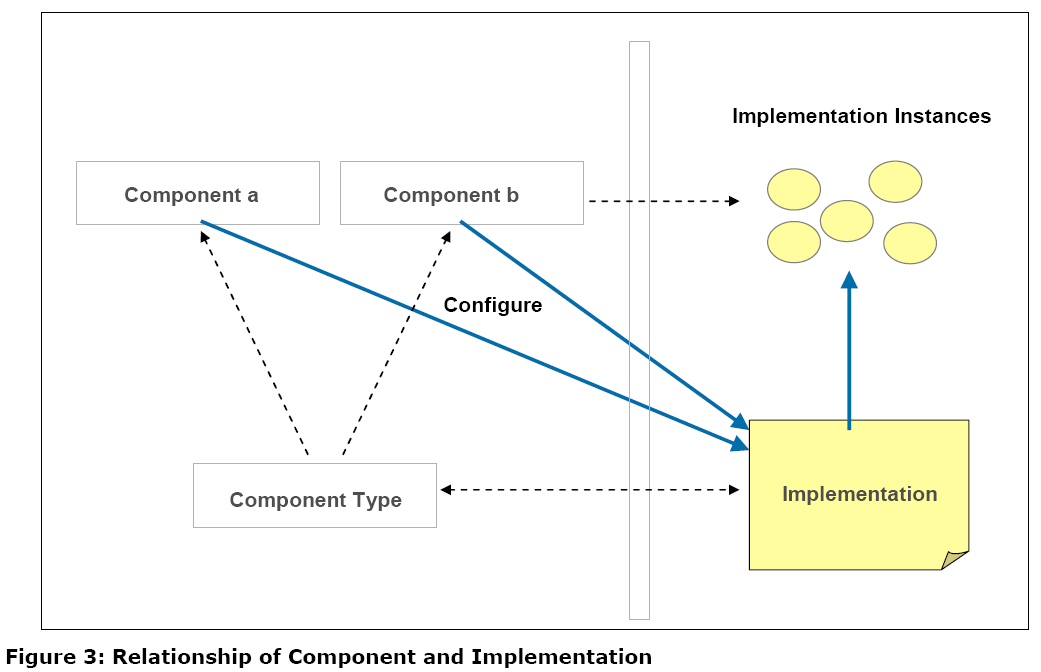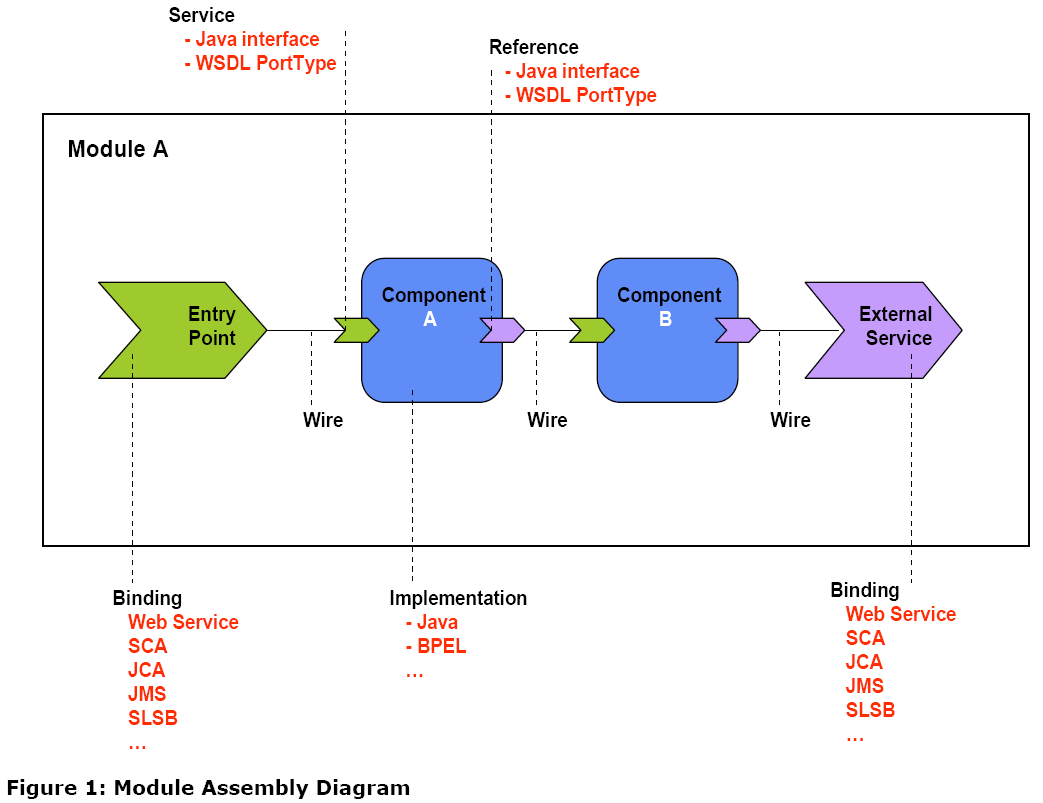轉(zhuǎn)載自Rinso的專欄
原文
SCA Module是緊耦合component的最大的組合物,同時也是松耦合SCA System中的基本單元,也就是說,很多緊耦合的東東組成Module,然后很多Module組成松耦合的System。我們都知道一味的緊耦合及松耦 合都是不好的,過分的緊耦合會降低系統(tǒng)的靈活性、可重用性等,而過分的松耦合會導(dǎo)致系統(tǒng)性能的下降、開發(fā)難度增加、代碼不直觀、測試難做等,因此,選擇一 個合適的緊耦合和松耦合之間的臨界點是很重要的,而Module就是這個臨界點。
Module有如下幾個標(biāo)準(zhǔn)特性:
< module /> 的name屬性表示module的名字,在一個SCA System中是唯一的。這個名字不能包含/或#字符。
< module /> 包含0或n個 < entryPoint /> 、 < component /> 、 < externalService /> 、?<wire />元素,這些元素的含義在之前的隨筆中 已經(jīng)說過。Component包含Module的業(yè)務(wù)邏輯,Wire描述Component之間的Service的連接,Entry Point定義Module提供的、可供外部訪問的public service,External Service表示Module對外部Service的依賴。
<component />必 須有一個implementation子元素,它指向component的具體實現(xiàn)。implementation元素的名字由兩部分組成: "implementation"+代表implementation-type的限定詞,例如:implementation.java表示是由 Java來實現(xiàn),implementation.bepl表示是由BPEL來實現(xiàn)。
確定一個Component Type需要兩個步驟:
SCA component type文件的擴(kuò)展名為".componentType",其中通過componentType元素來進(jìn)行配置,我們來看看它的schema:
讓我們來看一個例子,Java文件MyValueServiceImpl是這個例子中的Implementation,其SCA component type如下:


如果使用Java interface,Service方法的傳入?yún)?shù)和返回值可以使用Java class或Primitive type。最好使用SDO生成的Java class,因為它們和XML之間做了整合。(SDO也是IBM推出的一個SOA系列的標(biāo)準(zhǔn)。)
如果使用WSDL,Service方法的傳入?yún)?shù)和返回值則使用XML schema描述。XML schema種描述的參數(shù)以SDO DataObject的形式暴露給開發(fā)者。
一 個Component Implementation的Service是否是remotable的是由Service的Interface定義的。如果使用Java,為 Interface添加@Remotable annotation可以把Service聲明為remotable。WSDL定義的interface永遠(yuǎn)是remotable的。
典型的remoteable interface是粗力度的,用于松耦合的交互。Remotable Service Interface不允許函數(shù)重載。無論是在 Module之外還是在Module內(nèi)的其他Component中使用remotable Service,數(shù)據(jù)交換都采用by-value語義。
Remotable Serviced的Implementation可能會在Service調(diào)用過程中或調(diào)用之后改變傳入?yún)?shù),也可能在調(diào)用之后修改返回值。如果 remotable Service被locally或remotely調(diào)用,SCA container會保證傳入?yún)?shù)及返回值的改變對Service的調(diào)用者是不可見的(這就是by-value語義)。下面是一個remotable java interface的例子:
由local Interface提供的Service只能在同一Module中使用,它們不能通過Entry Point發(fā)布到外部。如果不聲明@Remotable,Java interface默認(rèn)為local。典型的local Interface是細(xì)粒度的,用于緊耦合的交互。它允許方法重載,并采用by-reference語義。
SCA Assembly Model涵蓋了兩種model:
SCA Assembly Model由一系列的artifact組成,這些artifact由XML文件中的element定義。下面先給出這些artifact的名詞:
一個Component由一個配置好的Implementation組成,這個Implementation就是實現(xiàn)business function的那段程序。Component使用具體的值來配置Implementation中聲明的可配置的屬性,Component也可以把 Implementation中聲明的wiring of reference配置到具體的目標(biāo)Service上去。
Module部署在SCA System中。一個SCA System往往表示一組相關(guān)Service的集合。為了方便建立和配置SCA System,Subsystem可以用來對Module進(jìn)行分組和配置。Subsystem包含Module Component(Module的配置好了的實例),和Module一樣,它也有Entry Point、External Service和Wire。
下面附上兩張圖來展示這些artifact之間的關(guān)系。


SOA and Web services 新手入門,轉(zhuǎn)自IBM DeveloperWorks,它的SOA and Web Service專區(qū)是學(xué)習(xí)SOA的很好的資源中心。本文章的內(nèi)容如下:
Elune Team由Allen Young,atlanta,Helena和silver.sun組成,近期目標(biāo)為參加2006 IBM杯中國高校SOA應(yīng)用大賽,因此會在比賽期間在BlogJava SOA Team Blog進(jìn)行相關(guān)討論,內(nèi)容以SOA為主,會涉及參賽項目管理,團(tuán)隊文化等。
歡迎各位對SOA感興趣的朋友加入討論BlogJava SOA Team Blog,下面是個人的幾點聲明,各位可以給我建議或補充。
SOA是一種態(tài)度,而不是一種技術(shù)。
原文
SCA Module是緊耦合component的最大的組合物,同時也是松耦合SCA System中的基本單元,也就是說,很多緊耦合的東東組成Module,然后很多Module組成松耦合的System。我們都知道一味的緊耦合及松耦 合都是不好的,過分的緊耦合會降低系統(tǒng)的靈活性、可重用性等,而過分的松耦合會導(dǎo)致系統(tǒng)性能的下降、開發(fā)難度增加、代碼不直觀、測試難做等,因此,選擇一 個合適的緊耦合和松耦合之間的臨界點是很重要的,而Module就是這個臨界點。
Module有如下幾個標(biāo)準(zhǔn)特性:
- 定義了Component可見性的邊界,Component不可以在Module之外直接被引用。
- 在同一個Module內(nèi),Service的本地調(diào)用采用by-reference語義(除了聲明為remotable的接口)。在Module之間,Service的遠(yuǎn)程調(diào)用采用by-value語義。
- 定義了部署的單元。Module用來為SCA System提供business service。
<?xml?version="1.0"?encoding="ASCII"?>
<module?xmlns=”http://www.osoa.org/xmlns/sca/0.9”
????xmlns:v="http://www.osoa.org/xmlns/sca/values/0.9"?name="xs:NCName">
????<entryPoint?name="xs:NCName" multiplicity="0..1?or?1..1?or?0..n?or?1..n"??>*
????????<interface.interface-type?/>
????????<binding.binding-type?uri="xs:anyURI"?/>+
????????<reference>wire-target-URI</reference>
????</entryPoint>
????<component?name="xs:NCName">*
????????<implementation.implementation-type?/>
????????<properties>?
????????????<v:property-name>property-value</v:property-name>+
????????</properties>
????????<references>?
????????????<v:reference-name>wire-target-URI</v:reference-name>+
????????</references>
????</component>
????<externalService?name="xs:NCName">*
????????<interface.interface-type?/>+
????????<binding.binding-type?uri="xs:anyURI"?/>*
????</externalService>
????<wire>*
????????<source.uri>wire-source-URI</source.uri>
????????<target.uri>wire-target-URI</target.uri>
????</wire>
</module>
<module?xmlns=”http://www.osoa.org/xmlns/sca/0.9”
????xmlns:v="http://www.osoa.org/xmlns/sca/values/0.9"?name="xs:NCName">
????<entryPoint?name="xs:NCName" multiplicity="0..1?or?1..1?or?0..n?or?1..n"??>*
????????<interface.interface-type?/>
????????<binding.binding-type?uri="xs:anyURI"?/>+
????????<reference>wire-target-URI</reference>
????</entryPoint>
????<component?name="xs:NCName">*
????????<implementation.implementation-type?/>
????????<properties>?
????????????<v:property-name>property-value</v:property-name>+
????????</properties>
????????<references>?
????????????<v:reference-name>wire-target-URI</v:reference-name>+
????????</references>
????</component>
????<externalService?name="xs:NCName">*
????????<interface.interface-type?/>+
????????<binding.binding-type?uri="xs:anyURI"?/>*
????</externalService>
????<wire>*
????????<source.uri>wire-source-URI</source.uri>
????????<target.uri>wire-target-URI</target.uri>
????</wire>
</module>
< module /> 的name屬性表示module的名字,在一個SCA System中是唯一的。這個名字不能包含/或#字符。
< module /> 包含0或n個 < entryPoint /> 、 < component /> 、 < externalService /> 、?<wire />元素,這些元素的含義在之前的隨筆中 已經(jīng)說過。Component包含Module的業(yè)務(wù)邏輯,Wire描述Component之間的Service的連接,Entry Point定義Module提供的、可供外部訪問的public service,External Service表示Module對外部Service的依賴。
Component
Component 是Implementation的配置實例,它即提供 Service也消費Service。多個Component可以使用并配置同一個Implementation,只要每個Component都采用不同 的配置。Implementation通過component type來定義可由Component配置的aspect。SCA支持多種不同的實現(xiàn)技術(shù),如Java、BEPL、C++。SCA定義了一種可擴(kuò)展機制來 引入新類型的Implementation。目前的規(guī)范不指定必須被SCA runtime支持的實現(xiàn)技術(shù),供應(yīng)商可以選擇他們認(rèn)為重要的技術(shù)予以支持。我們來看一下Component的schema:<component?name="xs:NCName">*
??? <implementation.implementation-type?/>
??? <properties>?
??????? <v:property-name>property-value</v:property-name>+
??? </properties>
??? <references>?
??????? <v:reference-name>wire-target-URI</v:reference-name>+
??? </references>
</component>
<component />的name屬性表示這個component的名字,它必須在當(dāng)前module中是唯一的。另外,當(dāng)前module中的entry point和external servic不可以和component重名。??? <implementation.implementation-type?/>
??? <properties>?
??????? <v:property-name>property-value</v:property-name>+
??? </properties>
??? <references>?
??????? <v:reference-name>wire-target-URI</v:reference-name>+
??? </references>
</component>
<component />必 須有一個implementation子元素,它指向component的具體實現(xiàn)。implementation元素的名字由兩部分組成: "implementation"+代表implementation-type的限定詞,例如:implementation.java表示是由 Java來實現(xiàn),implementation.bepl表示是由BPEL來實現(xiàn)。
<implementation.java?class="services.myvalue.MyValueServiceImpl"/>
<implementation.bpel?process="…"/>
<implementation.bpel?process="…"/>
Component Type
Component Type表示一個Implementation的可配置的東東,它由Implementation提供的Service、可設(shè)置的關(guān)聯(lián)到其他 Service的Reference和可設(shè)置的屬性組成。屬性和Reference將在使用這個Implementation的Component中具體 配置。確定一個Component Type需要兩個步驟:
- 從Implementation自身獲得信息(例如:從code annotation獲得信息)
- 從SCA component type文件獲得信息(XML配置文件)
SCA component type文件的擴(kuò)展名為".componentType",其中通過componentType元素來進(jìn)行配置,我們來看看它的schema:
<?xml?version="1.0"?encoding="ASCII"?>
<componentType?xmlns="http://www.osoa.org/xmlns/sca/0.9"?>
??? <service?name="xs:NCName">*
??????? <interface.interface-type/>
??? </service>
??? <reference?name="xs:NCName"?multiplicity="0..1?or?1..1?or?0..n?or?1..n"?>*
??????? <interface.interface-type/>
??? </reference>
??? <property?name="xs:NCName"?type="xs:QName"?many="xs:boolean"? default="xs:string"??required="xs:boolean"?/>*
</componentType>
<service />表示這個Component Type提供的Service,可以通過<interface.interface-type />設(shè)置其為remotable。<reference />表示這個Component Type依賴的其他Service,也可以通過<interface.interface-type />設(shè)置其為remotable,multiplicity屬性表示可以關(guān)聯(lián)到這個Reference的Wire的數(shù)量。<property />表示這個Component Type可配置的屬性。<componentType?xmlns="http://www.osoa.org/xmlns/sca/0.9"?>
??? <service?name="xs:NCName">*
??????? <interface.interface-type/>
??? </service>
??? <reference?name="xs:NCName"?multiplicity="0..1?or?1..1?or?0..n?or?1..n"?>*
??????? <interface.interface-type/>
??? </reference>
??? <property?name="xs:NCName"?type="xs:QName"?many="xs:boolean"? default="xs:string"??required="xs:boolean"?/>*
</componentType>
讓我們來看一個例子,Java文件MyValueServiceImpl是這個例子中的Implementation,其SCA component type如下:
<?xml?version="1.0"?encoding="ASCII"?>
<componentType?xmlns="http://www.osoa.org/xmlns/sca/0.9">
??? <service?name="MyValueService">
??????? <interface.java?interface="services.myvalue.MyValueService"/>
??? </service>
??? <reference?name="customerService">
??????? <interface.java?interface="services.customer.CustomerService"/>
??? </reference>
??? <reference?name="stockQuoteService">
??????? <interface.java?interface="services.stockquote.StockQuoteService"/>
??? </reference>
??? <property?name="currency"?type="xsd:string"?default="USD"/>
</componentType>
<componentType?xmlns="http://www.osoa.org/xmlns/sca/0.9">
??? <service?name="MyValueService">
??????? <interface.java?interface="services.myvalue.MyValueService"/>
??? </service>
??? <reference?name="customerService">
??????? <interface.java?interface="services.customer.CustomerService"/>
??? </reference>
??? <reference?name="stockQuoteService">
??????? <interface.java?interface="services.stockquote.StockQuoteService"/>
??? </reference>
??? <property?name="currency"?type="xsd:string"?default="USD"/>
</componentType>
相應(yīng)的Java代碼如下:
//?MyValueService?interface.
package?services.myvalue;
public?interface?MyValueService?{
????public?void?calculate();
}
package?services.myvalue;
public?interface?MyValueService?{
????public?void?calculate();
}
//?MyValueServiceImpl?class
package?services.myvalue;
import?services.customer.CustomerService;
import?services.stockquote.StockQuoteService;
public?class?MyValueServiceImpl?implements?MyValueService?{
????//?Code?annotation.?和XML的功能相同,兩者取一個使用就夠了。
????@Property
????private?String?currency?=?"USD";
????@Reference
????private?CustomerService?customerService;
????@Reference
????private?StockQuoteService?stockQuoteService;
????public?void?calculate()?{
????????//?do?your?real?business?logic?here.
????}
}
package?services.myvalue;
import?services.customer.CustomerService;
import?services.stockquote.StockQuoteService;
public?class?MyValueServiceImpl?implements?MyValueService?{
????//?Code?annotation.?和XML的功能相同,兩者取一個使用就夠了。
????@Property
????private?String?currency?=?"USD";
????@Reference
????private?CustomerService?customerService;
????@Reference
????private?StockQuoteService?stockQuoteService;
????public?void?calculate()?{
????????//?do?your?real?business?logic?here.
????}
}
Implementation
Implementation 是業(yè)務(wù)邏輯的具體實現(xiàn),這些業(yè)務(wù)邏輯會提供或消費Service。SCA支持多種實現(xiàn)技術(shù),如Java、BPEL或C++。我們已經(jīng)知道, Service、Reference和Property是Implementation中關(guān)于配置的東東,他們組成Component Type。在運行時,Implementation Instance是Implementation的實例化,它提供的業(yè)務(wù)邏輯和Implementation中的相同,但Property和 Reference則取決于Component中的配置。下圖描述了Component Type、Component、Implementation和Implementation Instance之間的關(guān)系:

Interface
Interface 負(fù)責(zé)定義一個或多個business function。這些business function通過Service提供給外部,外部通過Reference使用它們。Service由自己實現(xiàn)的Interface定義。SCA支持如 下3種Interface:
- Java interfaces
- WSDL 1.1 portTypes
- WSDL 2.0 interfaces
<interface.java?interface="NCName"?…?/>
其中interface屬性為Java interface的全名(包括package)。例如:<interface.java?interface="services.stockquote.StockQuoteService" />
<interface.wsdl?interface="xs:anyURI"?…?/>
其中interface屬性為portType/interface的URI,其格式為<WSDL-namespace-URI>#wsdl.interface(<portType or Interface-name>)。例如:<interface.wsdl?interface="http://www.stockquote.org/StockQuoteService#wsdl.interface(StockQuote)"/>
如果使用Java interface,Service方法的傳入?yún)?shù)和返回值可以使用Java class或Primitive type。最好使用SDO生成的Java class,因為它們和XML之間做了整合。(SDO也是IBM推出的一個SOA系列的標(biāo)準(zhǔn)。)
如果使用WSDL,Service方法的傳入?yún)?shù)和返回值則使用XML schema描述。XML schema種描述的參數(shù)以SDO DataObject的形式暴露給開發(fā)者。
一 個Component Implementation的Service是否是remotable的是由Service的Interface定義的。如果使用Java,為 Interface添加@Remotable annotation可以把Service聲明為remotable。WSDL定義的interface永遠(yuǎn)是remotable的。
典型的remoteable interface是粗力度的,用于松耦合的交互。Remotable Service Interface不允許函數(shù)重載。無論是在 Module之外還是在Module內(nèi)的其他Component中使用remotable Service,數(shù)據(jù)交換都采用by-value語義。
Remotable Serviced的Implementation可能會在Service調(diào)用過程中或調(diào)用之后改變傳入?yún)?shù),也可能在調(diào)用之后修改返回值。如果 remotable Service被locally或remotely調(diào)用,SCA container會保證傳入?yún)?shù)及返回值的改變對Service的調(diào)用者是不可見的(這就是by-value語義)。下面是一個remotable java interface的例子:
package?services.hello;
@Remotable
//?@AllowsPassByReference
public?interface?HelloService?{
????public?String?sayHello(String?message);
}
由External
Service提供的Service永遠(yuǎn)是remotable的。可以使用@AllowsPassByReference
annotation允許一個remotable
Service在被同一Module中的其他Component調(diào)用時使用by-reference語義,這樣可以提高性能。@Remotable
//?@AllowsPassByReference
public?interface?HelloService?{
????public?String?sayHello(String?message);
}
由local Interface提供的Service只能在同一Module中使用,它們不能通過Entry Point發(fā)布到外部。如果不聲明@Remotable,Java interface默認(rèn)為local。典型的local Interface是細(xì)粒度的,用于緊耦合的交互。它允許方法重載,并采用by-reference語義。
SCA Assembly Model涵蓋了兩種model:
- 用來組裝緊耦合服務(wù)的model
- 用來組裝松耦合面向服務(wù)系統(tǒng)的model
SCA Assembly Model由一系列的artifact組成,這些artifact由XML文件中的element定義。下面先給出這些artifact的名詞:
- Module
- Service
- Component
- Entry Point
- Reference
- External Service
- Wire
- Implementation
- SCA System
- Subsystem
- Module Component
一個Component由一個配置好的Implementation組成,這個Implementation就是實現(xiàn)business function的那段程序。Component使用具體的值來配置Implementation中聲明的可配置的屬性,Component也可以把 Implementation中聲明的wiring of reference配置到具體的目標(biāo)Service上去。
Module部署在SCA System中。一個SCA System往往表示一組相關(guān)Service的集合。為了方便建立和配置SCA System,Subsystem可以用來對Module進(jìn)行分組和配置。Subsystem包含Module Component(Module的配置好了的實例),和Module一樣,它也有Entry Point、External Service和Wire。
下面附上兩張圖來展示這些artifact之間的關(guān)系。


SOA and Web services 新手入門,轉(zhuǎn)自IBM DeveloperWorks,它的SOA and Web Service專區(qū)是學(xué)習(xí)SOA的很好的資源中心。本文章的內(nèi)容如下:
- 什么是面向服務(wù)的體系結(jié)構(gòu)(SOA)?
- 我可以用面向服務(wù)的體系結(jié)構(gòu)做什么?
- 構(gòu)成 SOA 的技術(shù)是什么?
- SOA 與其他技術(shù)的關(guān)系如何?
- 我可以如何構(gòu)建 SOA 系統(tǒng)?
- 我可以如何提高我的 SOA 技能?
- IBM 的什么工具和產(chǎn)品可用于 SOA?
Elune Team由Allen Young,atlanta,Helena和silver.sun組成,近期目標(biāo)為參加2006 IBM杯中國高校SOA應(yīng)用大賽,因此會在比賽期間在BlogJava SOA Team Blog進(jìn)行相關(guān)討論,內(nèi)容以SOA為主,會涉及參賽項目管理,團(tuán)隊文化等。
歡迎各位對SOA感興趣的朋友加入討論BlogJava SOA Team Blog,下面是個人的幾點聲明,各位可以給我建議或補充。
- 隨筆要與Team Blog主題相關(guān),否則將刪除。
- 做一個Critical Thinker,對自己的言論負(fù)責(zé)。
- 歡迎各種觀點(我們需要不同的聲音),歡迎爭論,不歡迎爭吵。
-
隨筆請用Courier New字體,2號字,以便保持整體風(fēng)格一致。
SOA是一種態(tài)度,而不是一種技術(shù)。



